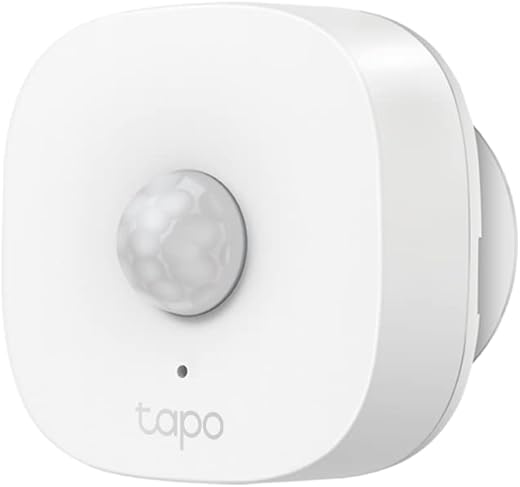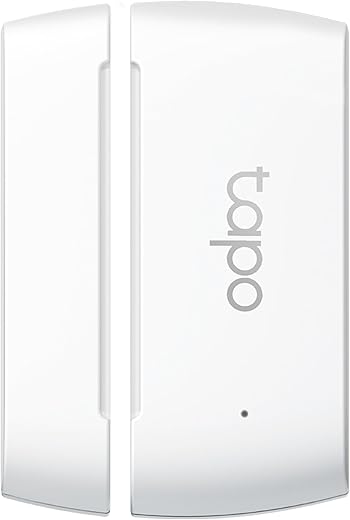
Have you ever wondered how your smart home knows when you’re coming and going? Or how it’s able to turn the lights on and off automatically? It’s all thanks to motion sensors! In this blog post, we’ll dive into the fascinating world of motion sensors in smart homes. We understand that the technology behind smart homes can sometimes feel overwhelming, but don’t worry – we’re here to break it down for you. Whether you’re a tech enthusiast or simply curious about how things work, this post will provide an insightful look into the inner workings of motion sensors and their role in creating a more convenient and efficient living environment. So let’s get started and uncover the magic behind these intelligent devices!
Top Smart Home Sensor Picks
What are motion sensors?
Motion sensors are essential components of smart home automation and security systems. They detect movement within their range and send a signal to trigger a specific action. In this blog section, we will delve into the details of motion sensors and how they work in the context of smart homes.
Types of Motion Sensors
There are several types of motion sensors commonly used in smart homes. Each type has its own working principle and is suited for different applications. The most popular types include:
- Passive Infrared (PIR) Sensors: These sensors detect infrared radiation emitted by objects in their field of view. When a person or object moves, the change in infrared radiation triggers the sensor. PIR sensors are commonly used in security systems and energy-saving applications.
- Ultrasonic Sensors: Ultrasonic sensors emit high-frequency sound waves and measure the time it takes for the waves to bounce back after hitting an object. If there is a change in the time it takes for the sound waves to return, the sensor is triggered. Ultrasonic sensors are effective in detecting large movements and are often used in automatic doors and occupancy detection.
- Microwave Sensors: Microwave sensors emit continuous microwave signals and measure the reflections caused by moving objects. Any change in the reflected signal triggers the sensor. Microwave sensors are highly sensitive and can detect even small movements, making them suitable for security applications.
- Dual Technology Sensors: Dual technology sensors combine two or more technologies, such as PIR and microwave or PIR and ultrasonic, to minimize false alarms and increase reliability. These sensors require both technologies to trigger before activating an action, making them more accurate and reliable.
How Motion Sensors Work
Motion sensors rely on various technologies to detect movement. Here’s a step-by-step breakdown of how motion sensors work:
- Detection: The motion sensor detects movement within its range by using the chosen technology, such as PIR, ultrasonic, microwave, or a combination.
- Signal Generation: When movement is detected, the motion sensor generates an electrical signal.
- Signal Transmission: The generated signal is transmitted to the central smart home hub or controller via wired or wireless communication protocols, such as Zigbee or Z-Wave.
- Action Triggering: The smart home hub or controller receives the signal and triggers a specific action based on the predefined rules or settings. This action can include turning on lights, adjusting the thermostat, or sending a notification to the homeowner’s smartphone.
Benefits of Motion Sensors in Smart Homes
Motion sensors bring several benefits to smart homes, enhancing convenience, energy efficiency, and security. Some of the key advantages include:
- Energy Efficiency: Motion sensors can automatically turn off lights, appliances, or heating/cooling systems when no one is present in a room, leading to energy savings and reduced utility bills.
- Convenience: With motion sensors, smart homes can automate various tasks, such as turning on lights when someone enters a room or unlocking the front door when a homeowner approaches.
- Security Enhancement: Motion sensors play a critical role in security systems, triggering alarms, notifying homeowners of any unusual movement, and deterring potential intruders.
- Occupancy Detection: Motion sensors can provide valuable data about occupancy patterns, enabling smart home systems to adapt and optimize energy usage based on the presence or absence of occupants.
Types of motion sensors
Motion sensors play a crucial role in smart home security systems, automating the detection of movement within a designated area. By understanding the different types of motion sensors available, homeowners can make informed decisions about which sensor best suits their needs. In this article, we will explore the four common types of motion sensors: Passive Infrared (PIR) sensors, Microwave sensors, Ultrasonic sensors, and Dual Technology sensors.
Passive Infrared (PIR) Sensors
Passive Infrared (PIR) sensors are the most widely used motion sensors in smart homes. These sensors detect infrared radiation emitted by warm objects, such as humans or animals, within their field of view. Here are some key features and benefits of PIR sensors:
- They are cost-effective and easy to install.
- PIR sensors are highly reliable and have a low false alarm rate.
- These sensors are ideal for indoor use and work well in small to medium-sized rooms.
- Popular PIR sensor brands include Honeywell, Bosch, and Philips.
Microwave Sensors
Microwave sensors use microwave pulses to detect motion. They work by emitting continuous microwave signals and measuring the reflected signal when an object moves within the sensor’s range. Here are some notable features and benefits of microwave sensors:
- They offer a wider detection range compared to PIR sensors.
- Microwave sensors can penetrate walls and other obstacles, making them suitable for outdoor use.
- These sensors are effective in detecting both large and small movements.
- Popular microwave sensor brands include Texecom, DSC, and Optex.
Ultrasonic Sensors
Ultrasonic sensors emit high-frequency sound waves and detect changes in the echo patterns caused by motion. They are commonly used in indoor settings and provide reliable detection capabilities. Here are some important details about ultrasonic sensors:
- They are sensitive to small movements and can detect motion around corners.
- Ultrasonic sensors work well in large areas, such as warehouses or open-plan living spaces.
- These sensors are immune to temperature changes, making them reliable in various environments.
- Popular ultrasonic sensor brands include Paradox, Visonic, and DSC.
Dual Technology Sensors
Dual Technology sensors combine two different technologies, typically PIR and microwave, to enhance motion detection accuracy and reduce false alarms. By using both technologies simultaneously, these sensors provide a higher level of security. Here are some key points to consider about dual technology sensors:
- They offer reliable detection by cross-verifying signals from both PIR and microwave sensors.
- Dual technology sensors are less prone to false alarms caused by environmental factors.
- These sensors are suitable for both indoor and outdoor applications.
- Popular brands that offer dual technology sensors include Honeywell, Bosch, and DSC.
Comparison Table
| Sensor Type | Detection Method | Detection Range | Suitable Environments | Popular Brands |
|---|---|---|---|---|
| PIR Sensors | Infrared radiation | Small to medium | Indoor use | Honeywell, Bosch, Philips |
| Microwave Sensors | Microwave pulses | Wide | Indoor and outdoor | Texecom, DSC, Optex |
| Ultrasonic Sensors | High-frequency sound waves | Large | Indoor use | Paradox, Visonic, DSC |
| Dual Technology Sensors | Combination of PIR and microwave | Wide | Indoor and outdoor | Honeywell, Bosch, DSC |
In conclusion, choosing the right motion sensor for your smart home security system is crucial for effective detection and prevention. By understanding the differences between Passive Infrared (PIR) sensors, Microwave sensors, Ultrasonic sensors, and Dual Technology sensors, homeowners can make an informed decision that best suits their specific needs. Whether it’s a small indoor space or a wide outdoor area, there is a motion sensor available to enhance the security of your smart home.
How do motion sensors work?
Motion sensors play a crucial role in the functionality of smart homes. By detecting movement within a given area, they enable automation and enhance security measures. In this blog section, we will explore the inner workings of motion sensors, explaining the principles behind each type and the technologies they utilize to detect motion.
Passive Infrared (PIR) Sensors
- PIR sensors are the most commonly used type of motion sensors in smart homes.
- These sensors detect changes in infrared radiation emitted by living organisms and convert them into electrical signals.
- When a warm object, such as a person or animal, moves within the sensor’s field of view, it triggers an alarm or activates a specific function.
- PIR sensors are widely used in security systems, lighting controls, and energy management systems in smart homes.
Ultrasonic Sensors
- Ultrasonic sensors emit high-frequency sound waves and detect the echo generated when the waves bounce back from objects in their path.
- By measuring the time it takes for the echo to return, the sensor can determine the distance between itself and the object.
- When the distance changes due to motion, the sensor triggers a response.
- Ultrasonic sensors are commonly used in automatic doors, occupancy detection systems, and smart lighting systems.
Microwave Sensors
- Microwave sensors emit continuous microwave signals and measure the reflection of these signals when they encounter an object.
- These sensors detect motion by analyzing changes in frequency caused by the Doppler effect.
- They are highly sensitive and can detect even the slightest movement, making them suitable for security systems.
- Microwave sensors are often used in automatic doors, security systems, and industrial applications.
Dual Technology Sensors
- Dual technology sensors combine two different technologies, such as PIR and microwave, to improve accuracy and reduce false alarms.
- These sensors require both technologies to detect motion before triggering a response.
- By eliminating false alarms caused by environmental factors, dual technology sensors are ideal for high-security areas.
- They are commonly used in commercial buildings, banks, and museums.
Choosing the Right Motion Sensor
When selecting a motion sensor for your smart home, consider the following factors:
- Detection Range: Determine the range over which the sensor can detect motion. This will depend on the size of the area you want to monitor.
- Sensitivity: Opt for sensors with adjustable sensitivity levels to avoid false alarms or under-detection.
- Power Source: Consider whether the sensor operates on batteries or requires a wired power source.
- Integration: Check if the sensor is compatible with the smart home hub or automation system you are using.
- Price: Compare prices and features of different brands or models to find the one that suits your requirements and budget.
Motion sensors are essential components of a smart home automation system. By understanding how these sensors work, you can optimize their performance and make informed decisions when incorporating them into your home. Whether it’s securing your property or automating daily tasks, motion sensors can greatly enhance the functionality and convenience of your smart home.
Applications of motion sensors in smart homes
Motion sensors are an integral part of a smart home system, providing numerous benefits in terms of security, energy efficiency, and convenience. In this blog section, we will explore the practical applications of motion sensors in smart homes, highlighting their importance and usefulness in everyday life.
Security:
One of the primary applications of motion sensors in smart homes is enhancing security measures. By detecting movement within the home, motion sensors can trigger alarms, send notifications, or activate surveillance cameras. Here are some specific security-related applications:
- Intrusion Detection: Motion sensors can alert homeowners when unexpected movement is detected, helping prevent break-ins or vandalism.
- Window and Door Monitoring: Motion sensors can be installed near windows and doors to detect unauthorized entry attempts.
- Pet Monitoring: Motion sensors can differentiate between human and pet movement, ensuring that false alarms are not triggered by pets.
Energy Efficiency:
Motion sensors play a crucial role in optimizing energy consumption within a smart home. By sensing occupancy and movement, they can automate lighting, heating, and cooling systems, resulting in significant energy savings. Here are some energy-efficient applications of motion sensors:
- Lighting Automation: Motion sensors can turn on lights when someone enters a room and turn them off when the room is unoccupied, eliminating the need for manual switches.
- Occupancy-based Heating and Cooling: Motion sensors can adjust thermostat settings based on room occupancy, ensuring that energy is not wasted in unoccupied spaces.
- Smart Appliances Control: Motion sensors can activate or deactivate appliances, such as televisions or coffee makers, based on the presence or absence of individuals in a room.
Convenience:
Motion sensors offer convenience and ease of use in smart homes, making daily routines more seamless and efficient. They enable hands-free control of various devices and systems, making life easier for homeowners. Here are some convenient applications of motion sensors:
- Automatic Entryway Lighting: Motion sensors can turn on lights in entryways or hallways when someone approaches, eliminating the need to fumble for light switches in the dark.
- Smart Home Voice Activation: Motion sensors can detect movement and trigger voice-activated assistants, allowing users to control various devices through voice commands.
- Room-by-Room Automation: Motion sensors can enable customized automation in different rooms, such as automatically adjusting the blinds or playing music based on individual preferences.
In conclusion, motion sensors have become an essential component of smart home systems, providing security, energy efficiency, and convenience benefits. Whether it’s enhancing security measures, optimizing energy consumption, or improving daily routines, motion sensors play a vital role in creating a truly smart and connected home.
Key Benefits of Motion Sensors in Smart Homes:
- Enhanced security and intruder detection.
- Energy-efficient automation of lighting and climate control.
- Hands-free control of appliances and devices.
- Customized room-by-room automation.
- Improved convenience and seamless daily routines.
Comparison Table:
| Aspect | Traditional Homes | Smart Homes with Motion Sensors |
|---|---|---|
| Security | Rely on manual locks and alarms | Motion sensors trigger alarms and send notifications in case of unauthorized movement |
| Energy Efficiency | Manual control of lights and thermostats | Motion sensors automate lighting and adjust thermostat settings based on occupancy |
| Convenience | Manual operation of switches and appliances | Motion sensors enable hands-free control and automation of various devices |
| Customization | Limited customization options | Motion sensors allow room-by-room automation adapted to individual preferences |
By incorporating motion sensors into your smart home system, you can enhance security, optimize energy usage, and enjoy the convenience of a truly connected home.
Understanding the inner workings of motion sensors in the realm of smart homes
In conclusion, motion sensors are a crucial element in the functioning of smart homes. They offer benefits in terms of security, energy efficiency, and convenience. When selecting motion sensors for your smart home, it is important to take into account factors such as their range, sensitivity, power source, and compatibility with your existing smart home system. By gaining a deeper understanding of how motion sensors operate and their diverse applications, you will be able to make well-informed choices to create a safer and more efficient living space.















